The sprawling West Point facility extends all the way down to the river and takes up several hillsides. The older buildings look like a medieval castle fortress. Before 9/11 passing cruisers could tie up at the facility docks and take a tour. I could see groups of people walking around, and I figured they might be new recruits, with their parents, getting ready to begin the Fall school term. It was very disconcerting not to see an American flag flying at the facility until we got all the way around to the northern end of the campus, where the buildings are set back farther from the river.
With the flatter land areas on the nearby hillsides we can see large estate homes, old mansions, colleges, and government buildings of various ages and architectural designs. There are numerous tour boats, some replica crafts of days gone by, that probably tell their travelers the names and histories of the buildings we are seeing. There is lot to see, so those cruisers can't be bored.
A lot of the hillside buildings are too far away to be able to photograph well, but we can get real close to the lighthouses, some of which have very unique styles and their own interesting locations. The Esopus lighthouse, built in 1872, is one of the few that we've seen that has marked a mud river shoal; when we passed it was low tide, revealing a huge mud flat.
The new Queen of the Hudson had her 11th birthday while we were underway. I baked a cake, so that she could watch the rest of the crew eat it on her behalf. She got to lick one of the plates.
We decided to visit Kingston, the original capital of New York. Our cruising guides suggested possible anchorages in Rondout Creek which flows right along the original Kingston waterfront. It is easy to see why Kingston was such an important shipping center of commerce and business; the creek is very deep and wide for quite a distance, and it has a broad entrance right off the river, marked by the beautiful 1915 Rondout lighthouse, the last family occupied lighthouse on the Hudson. However, it is now filled with many marinas, boatyards, bulkheads, and docks and a gazillion vessels of various sorts. We took FLUKE about 3.5 miles up the creek almost to the low, fixed bridge before we ran out of water. The farther in we went the more apparent it was that FLUKE was one of its own kind; most of the other boats were smaller day or weekend cruisers, and they were packed in for Saturday fun along the docks and beached on the sand bars. There was no room for us, so we slowly headed back to the Hudson.
We ended up dropping the hook just south of the lighthouse off Port Ewen, a hamlet community located on the south side of Rondout Creek. Even though we weren't that far from the main channel the wakes from passing boats weren't too bothersome, we had a great breeze, and we could watch the boating traffic on the river.
Sunday was slated to be a going to land day, starting out with a walk on land with Ursa to check out the residential community of Port Ewen, or so we thought. Cruisers frequently have a problem trying to find a place to safely land their dinghy when they are anchored out. We couldn't see a boat ramp from the river, but we could see a private yacht club called Hidden Harbor. We dinghied over to it and asked if we could land our dinghy and go for a walk, but were told that, for “insurance reasons” unless we were a member or guest of a member we couldn't land. I wondered if the rangers at Bear Mountain had notified the communities along the way about our “criminal” record of behavior.
There was a town “beach” right next to the yacht club where we may have been able to land the dinghy, but the whole shoreline area in front to about 100 yards out into the river was filled in with this noxious, invasive weed called Chinese water chestnut. Since we hadn't had any experience with that pest, we wondered if we could motor through what looked like a thin section. Big mistake. We went about 10' before the prop was fouled. That plant is all connected underneath the water to each other plant like a big piece of lace, and then many of the sections are rooted. To make matters worse, the plant has these hard, bladder-like floating bulbs the size of a silver dollar that are prickly. Wayne got stuck having to pull the plants out of the prop and then got real grumpy.
Besides the weed problem, Wayne was already “disturbed” because we had gotten run off from the yacht club, not that the guy who told us we couldn't land was rude about it. Wayne just doesn't like a negative encounter with anyone. I, on the other hand, take the attitude that it doesn't hurt to ask, and we won't be shot or even arrested for trying. Plus, we will never see that person again, so who cares what he thinks of us. Let's just have a life list draw!
So, back to the point I'm trying to make. We still hadn't reached land. I had noticed that on the east side of the river there appeared to be some sort of public landing area that had been getting filled up with colorful tents all morning. I suggested that we cross over the river and go investigate that activity. I said tents like that were usually associated with some special event and we had nothing more to lose if we went to check it out. Since that logic prevailed, we motored across the river.
We discovered Rhinecliff, the hamlet of Rhinebeck, a dutch town from 1696. The town was having their annual Waterfront Day, and the people were very friendly (both to people and dogs), receptive to questions and more than willing to share information. Many of the Hudson River communities are holding events throughout the year to recognize the quadracentennial birthday of Henry Hudson discovering the Hudson River, 1609-2009. Vendor tents sold shirts commemorating the discovery. There were water safety displays, craft sales, food sales, face painting, fund raiser projects (trolley, fire, library, museum), and educational exhibits. The Coast Guard had one of the boats they use to service channel markers docked with a channel marker aboard and free tours. We checked out all the exhibits and took a walk up into town to look at the old homes and buildings. We wanted Ursa to have a nice walk since she would be confined on FLUKE during the afternoon.
After lunch, we dinghied back up Rondout creek to visit the Hudson Maritime Museum and the Kingston waterfront area. Since we were going to visit the museum ($4 admission fee) we could dock in one of their slips. Even though there is a municipal marina there is no official free public landing area. Like many small towns, Kingston is having a difficult time trying to keep its waterfront alive and doesn't have the funds to keep up enough dock space even though there is plenty of room available. The museum is housed in one of the old waterfront brick commercial buildings and relies on volunteers to keep the place running.
This museum is the only one featuring the Hudson River along the entire 300 miles of its length. Most of the displays feature old photographs, models, and various parts and memorabilia from the early days of river life on the Hudson. You can travel through time from its original discovery by Henry Hudson and his 60' sailing ship, the Half Moon. Oddly, Hudson was hired by the Dutch government to find a trading route that could be used to connect Asia and the Orient. Even though he didn't accomplish his goal, he opened up the river route to the development of many coastal communities that became important centers for the military and commerce which help develop the wealth and success of early America.
There are displays featuring the development of the steamboat and how important those ships became for moving people and goods along the river. There is even a section devoted to the importance of the river lighthouses, with a scaled replica of the Rondout lighthouse, as seen in the background behind me in the steamboat wheel photo.
There are also some educational displays and a video about the ecology of the Hudson River and its importance as a major source of drinking water for millions of people. One segment even talks about that awful pest weed that we tangled with. The river is an important habitat for sturgeon and stripers. The peregrine falcon, once extirpated from the river, has been reintroduced and is making a comeback, nesting in the high bridges that cross the river. The bald eagle has established several nesting habitats; we saw one flying right alongside of us this morning! For a little place, there is something that should interest everyone.
There are many interesting-looking store fronts and buildings in the old waterfront area, but most of them are vacant. At least they aren't all beat up and do look nice from the outside The main street is on a steep hill sloping all the way down to the water's edge; it is good exercise to walk up to the top. If you ask someone for directions, they reply by saying it's either up or down the hill. We walked to a Stewart's convenience store, all up hill and then some, probably about a mile. There are some nice views of the river from way up on the hillside.
The Main Drag
Arriving back to FLUKE in the later part of the afternoon helped us avoid being aboard d
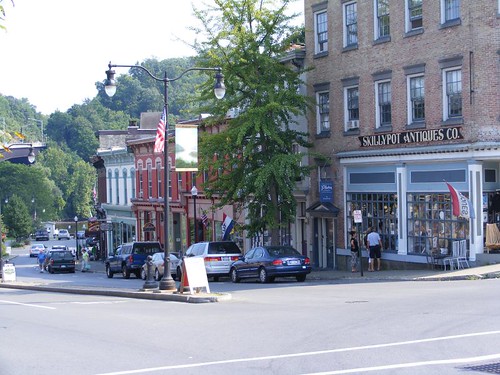 uring the Sunday driver wakes for the most part. We began to discuss the plans for the next couple of days of travel, where we would need to find a calm anchorage so we could lower the mast and get ready to pass through the first lock and extra low bridge. Both of those events should be good for some yelling and anal distress!
uring the Sunday driver wakes for the most part. We began to discuss the plans for the next couple of days of travel, where we would need to find a calm anchorage so we could lower the mast and get ready to pass through the first lock and extra low bridge. Both of those events should be good for some yelling and anal distress!
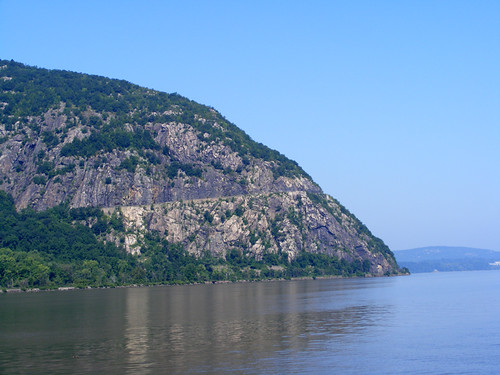
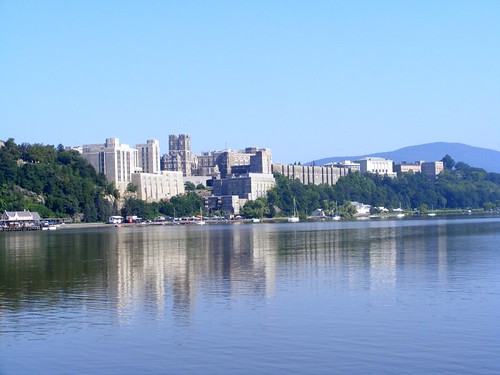
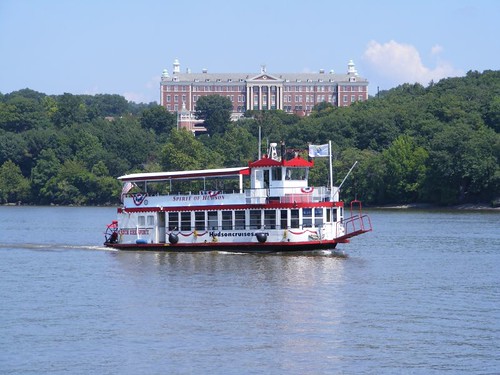
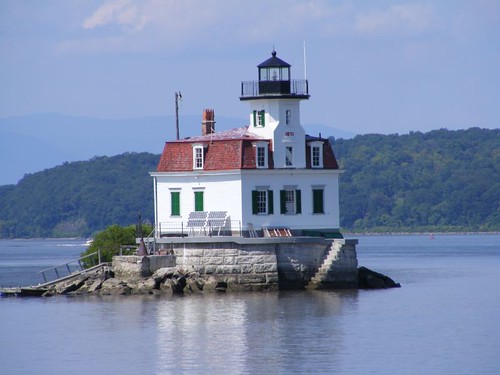
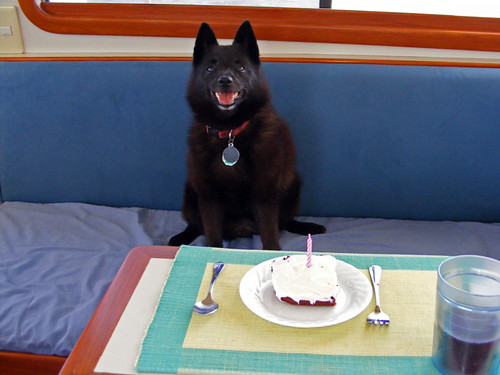
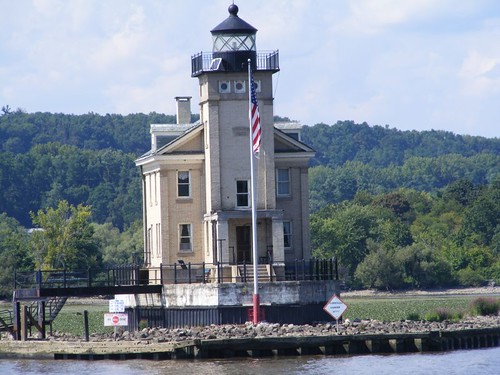

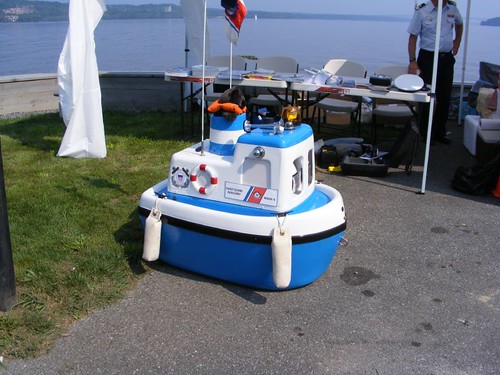
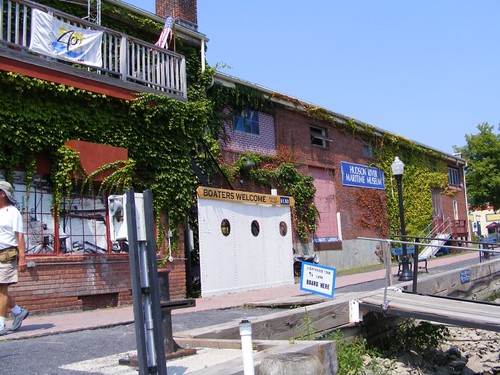
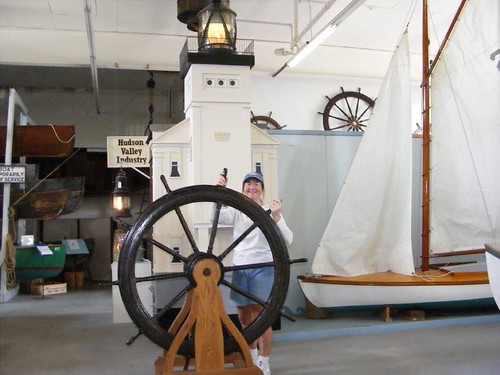








What did you think of Bannerman 'Castle' when you went by it? You can take tours of West Point which could have been the groups of people you saw.
ReplyDelete